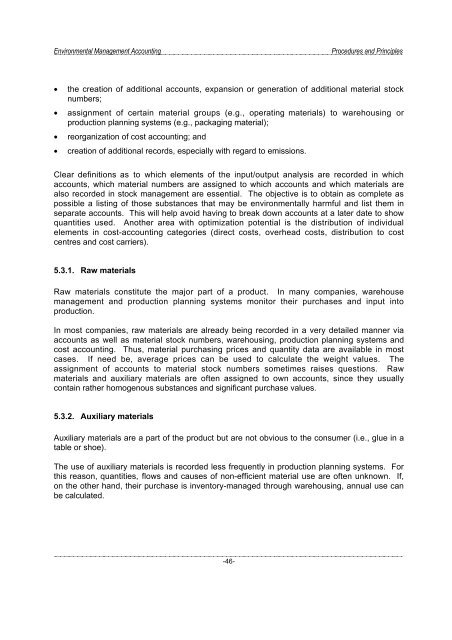Environmental Management Accounting Procedures and Principles
Environmental Management Accounting Procedures and Principles
Environmental Management Accounting Procedures and Principles
Create successful ePaper yourself
Turn your PDF publications into a flip-book with our unique Google optimized e-Paper software.
<strong>Environmental</strong> <strong>Management</strong> <strong>Accounting</strong><br />
<strong>Procedures</strong> <strong>and</strong> <strong>Principles</strong><br />
• the creation of additional accounts, expansion or generation of additional material stock<br />
numbers;<br />
• assignment of certain material groups (e.g., operating materials) to warehousing or<br />
production planning systems (e.g., packaging material);<br />
• reorganization of cost accounting; <strong>and</strong><br />
• creation of additional records, especially with regard to emissions.<br />
Clear definitions as to which elements of the input/output analysis are recorded in which<br />
accounts, which material numbers are assigned to which accounts <strong>and</strong> which materials are<br />
also recorded in stock management are essential. The objective is to obtain as complete as<br />
possible a listing of those substances that may be environmentally harmful <strong>and</strong> list them in<br />
separate accounts. This will help avoid having to break down accounts at a later date to show<br />
quantities used. Another area with optimization potential is the distribution of individual<br />
elements in cost-accounting categories (direct costs, overhead costs, distribution to cost<br />
centres <strong>and</strong> cost carriers).<br />
5.3.1. Raw materials<br />
Raw materials constitute the major part of a product. In many companies, warehouse<br />
management <strong>and</strong> production planning systems monitor their purchases <strong>and</strong> input into<br />
production.<br />
In most companies, raw materials are already being recorded in a very detailed manner via<br />
accounts as well as material stock numbers, warehousing, production planning systems <strong>and</strong><br />
cost accounting. Thus, material purchasing prices <strong>and</strong> quantity data are available in most<br />
cases. If need be, average prices can be used to calculate the weight values. The<br />
assignment of accounts to material stock numbers sometimes raises questions. Raw<br />
materials <strong>and</strong> auxiliary materials are often assigned to own accounts, since they usually<br />
contain rather homogenous substances <strong>and</strong> significant purchase values.<br />
5.3.2. Auxiliary materials<br />
Auxiliary materials are a part of the product but are not obvious to the consumer (i.e., glue in a<br />
table or shoe).<br />
The use of auxiliary materials is recorded less frequently in production planning systems. For<br />
this reason, quantities, flows <strong>and</strong> causes of non-efficient material use are often unknown. If,<br />
on the other h<strong>and</strong>, their purchase is inventory-managed through warehousing, annual use can<br />
be calculated.<br />
-46-




